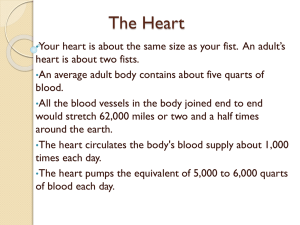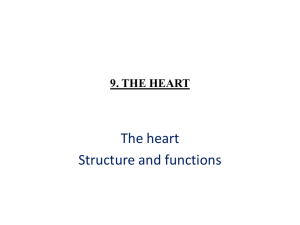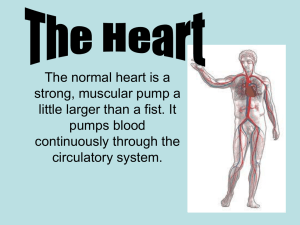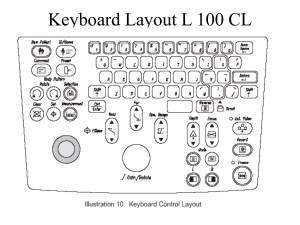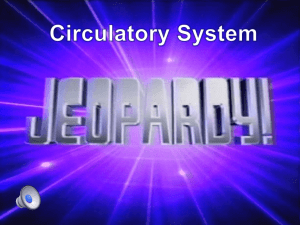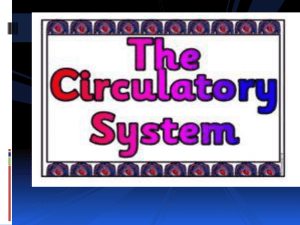Introduction to Cardiac Medicine
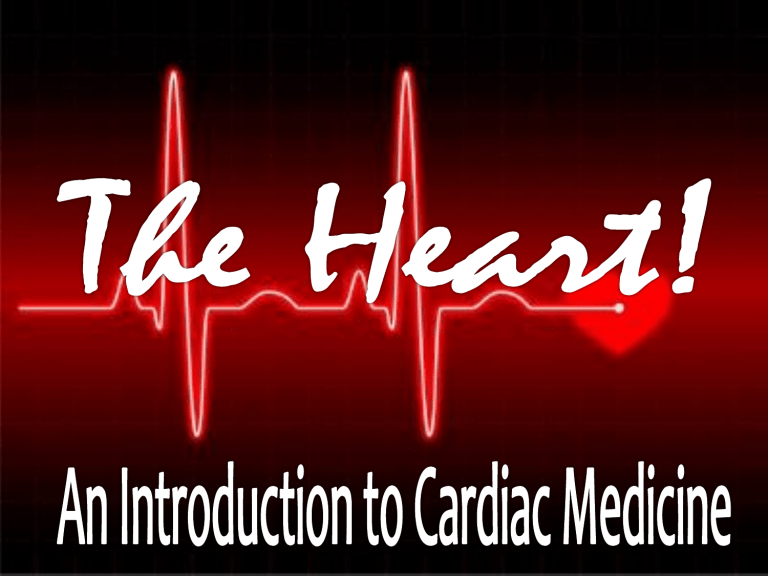
• Every cell in your body needs oxygen to live.
The role of the heart is to send blood that is full of oxygen to all the cells in your body.
• Blood has two major parts:
– 55% plasma
• 92%water
• 8% fats, proteins, ions, sugars, amino acids and nitrogenous waste
– 45% blood cells
• 99% red blood cells
• 1% platelets & white blood cells
• Plasma is the liquid portion of blood – a protein-salt solution in which red and white blood cells and platelets are suspended.
• Plasma also contains proteins:
– albumin (a protein needed to both maintain growth and repair tissues),
– fibrinogen (clotting of blood)
– globulins (antibodies, which to identify and neutralize foreign objects such as bacteria and viruses).
• RBCs carry fresh oxygen throughout the body - gives your blood its bright red color
• RBCs are round with a flattish, indented center (like doughnuts without a hole)
• Hemoglobin is the protein inside RBCs that carries oxygen.
• RBCs also remove carbon dioxide from your body, transporting it to the lungs for you to exhale.
• RBCs are made inside your bones, in the bone marrow.
• RBCs typically live for about 120 days, and then they die.
• WBCs account for only about 1% of your blood
– Also called leukocytes
• Your immunity cells; flow through your bloodstream to battle viruses, bacteria, and other foreign invaders that threaten your health
• Produced inside the bone marrow; stored in your blood and lymphatic tissues
• Lifespan of 1-3 days; bone marrow is constantly producing them
• Monocytes. They have a longer lifespan than many white blood cells and help to break down bacteria.
• Lymphocytes. They create antibodies to defend against bacteria, viruses, and other potentially harmful invaders.
• Neutrophils. They kill and digest bacteria and fungi. They are the most numerous type of white blood cell and your first line of defense when infection strikes.
• Basophils. These small cells appear to sound an alarm when infectious agents invade your blood. They secrete chemicals such as histamine, a marker of allergic disease, that help control the body's immune response.
• Eosinophils. They attack and kill parasites, destroy cancer cells, and help with allergic responses.
• Not actually cells (small fragments of cells)
• Help the clotting process (or coagulation); gather at the site of an injury, stick to the lining of the injured blood vessel, and form a platform on which blood coagulation can occur – a scab!
– A higher than normal number of platelets can cause unnecessary clotting, which can lead to strokes and heart attacks
– Too few platelets can lead to extensive bleeding
• You will now make 250 grams of "blood.”
• Today you will use weight instead of volume because the materials you will use are granular solids with air spaces between the grains.
– A true volume cannot be found by simply putting the materials in a graduated cylinder
1. The passageways that carry this blood are called blood vessels.
1. The passageways that carry this blood are called blood vessels
2. Arteries carry oxygen-rich blood to the cells that need it
– The largest artery is the aorta
1.
The passageways that carry this blood are called blood vessels.
2. Arteries carry oxygen-rich blood to the cells that need it.
– The largest artery is the aorta.
3. Veins carry blood back to the heart again. It is pumped into your lungs where it picks up oxygen and then goes back to your heart, from where it is pumped back again into your body.
1.
It only takes about 20 seconds to pump blood to every cell of your body.
• The human heart is a muscle that lies left of the
chest .
• It has about the size of a fist .
• The heart is like a pump that sends blood around your body. The blood gives you the
oxygen you need .
• An average heart pumps about 70 milliliters of blood into your body with every beat .
– That’s about 5 liters every minute or about 7200 liters every day.
• The heart is made up of 4 chambers
– Atria: the top two chambers
• These fill with blood
– Ventricles: bottom two chambers
• Their job is to squirt out the blood
– In the middle of the heart there is a thick muscle called the septum that separates the left and the right side
• The atria and ventricles work together. The atria fill with blood and when they are full they let the blood into the ventricles.
• When these ventricles pump the blood out of the heart, the atria fill up again and the whole process starts again.
• There are four valves in the heart that make sure that the blood is pumped in the right direction.
• When the heart contracts , it pumps blood from its chambers into the body.
• Then the heart muscle relaxes and lets the chambers fill up.
• Valves are flap-like structures that allow blood to flow in one direction.
• Prevents the back flow of blood as it is pumped.
• The tricuspid valve
• The pulmonary valve
• The mitral valve
• The aortic valve
1. The veins of the body all eventually drain into the right atrium
2. Once the right atrium is full, the tricuspid valve opens, allowing the de-saturated blood to flow into the right ventricle
– De-saturated = no oxygen
3. The right ventricle then fills with the desaturated blood.
– As the pressures begin to change in the right atrium and right ventricle, the tricuspid valve closes.
• As the de-saturated blood leaves the right
ventricle, it passes through the pulmonary valve, which has been closed as the right ventricle was filling.
• The pulmonary valve opens, allowing the blood to leave the right ventricle and flow to the
lungs via the pulmonary artery.
• Once the right ventricle has emptied, the pulmonary valve closes, thereby keeping the blood from re-entering the right ventricle.
• As the de-saturated blood passes through the lungs, the carbon dioxide that was added to the red blood cells by the body’s organs is exchanged for a new supply of oxygen.
• The newly oxygenated blood then flows from the lungs to the left atrium, which is the receiving chamber on the left side of the heart.
• The valve located in the left atrium is the mitral valve.
• As the left atrium fills with the newly oxygenated blood, the mitral valve remains closed.
• As the pressure changes within the left atrium and left ventricle, the mitral valve opens, allowing the oxygenated blood to flow into the left ventricle.
• As the left ventricle fills, the pressures in the left atrium and left ventricle begin to change.
• Once the left ventricle is filled, the mitral valve closes as the left ventricle begins to contract.
• By closing at this time, the mitral valve prevents the oxygenated blood in the left ventricle from flowing back to the lungs.
• The left ventricle is the pumping chamber of the left side of the heart and is the most muscular portion of the heart.
– When you hear some say their blood pressure is 120 over 80, it is the left ventricle that is generating these pressures.
• As the left ventricle contracts, the oxygenated blood leaves the heart and crosses the aortic valve, which is the valve that helps to control the flow of blood out of the heart to the body.
• The oxygenated blood leaving the left ventricle and crossing the aortic valve enters the main artery of the body, known as the aorta.
• The aorta then travels to the body’s organs via branches that carry the blood to the individual organs.
Put It All Together Now…
• The amount of pressure on one’s arteries every time the hear beats.
• Systolic Pressure – the first number
– The amount of pressure on the arteries when the heart beats
• Diastolic Pressure – the second number
– The pressure on the hearties when the heart is NOT beating
• Average blood pressure readings for teenagers is 100/60
• High Blood Pressure
– A sign that the heart is working harder than it should to push the blood through the blood vessels
• Reading is 140/90 or over
• Leads to enlargement of the main pumping chamber of the heart (the left ventricle) and overtaxing the heart
– Stroke, eye damage, blood clots & aneurysm, heart attack/failure, kidney damage
• Risk factors – overweight, eating a diet high in sodium, smoking, stress, lack of exercise, family history, age
Hypertension
• Low Blood Pressure
– May be a sign of good health and a decreased risk of heart disease, but in some people, hypotension can be a problem
• Can result in a decreased supply of oxygen and nutrients to your brain, which can eventually lead to life-threatening shock, damaging your brain or heart
• Reading is under 90/60
